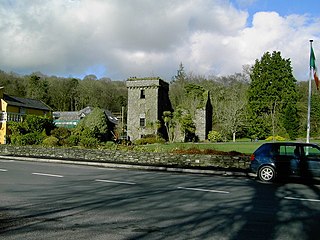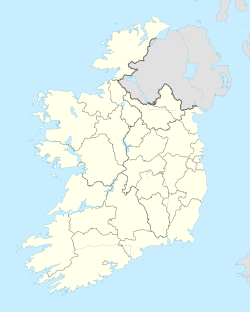
Ardfert is a village and civil parish in County Kerry, Ireland. Historically a religious centre, the economy of the locality is driven by agriculture and its position as a dormitory town, being only 8 km (5 mi) from Tralee. The population of the village was 749 at the 2016 census.

Glanmire is a suburban town 9 kilometres (5.6 mi) from Cork city centre, in the civil parish of Rathcooney, County Cork, Ireland. Glanmire is within the administrative area of Cork City Council and the Dáil constituency of Cork North-Central.

Newcastle West or simply Newcastle is a town in west County Limerick, Ireland. It is the largest town in the county, excluding Limerick city. It is also the county town, and sits on the River Arra which flows into the River Deel. Newcastle West is in the middle of a great bowl-shaped valley in West Limerick, known one time as the valley of the Wild Boar, apparently due to the abundance of this animal here when the area was thickly wooded. The crest of the town carries the image of a wild boar. The town is partly in the civil parish of Newcastle.

Charleville is a town in County Cork, Ireland. It lies in the Golden Vale, on a tributary of the River Maigue, near the border with County Limerick. Charleville is on the N20 road and is the second-largest town between Limerick and Cork, the largest being Mallow. The Roman Catholic parish of Charleville is within the Diocese of Cloyne. Significant industries in the town include Kerry Co-op and the construction and services sectors.

Bruff is a town in east County Limerick, in the midwest of Ireland, located on the old Limerick–Cork road (R512). The town lies on the Morning Star river, with two bridges in the town itself. The horseshoe lake of Lough Gur is nearby. The town is in a townland and civil parish of the same name.

Churchtown is a largely residential affluent suburb on the southside of Dublin, between Rathfarnham and Dundrum.
Ballyhea or Ballyhay is a townland and civil parish in north County Cork, Ireland. Located near to the County Limerick border, the village of Ballyhea lies on the main N20 Cork–Limerick road, 3.5 km south of Charleville. It lies approximately 110 m above sea level.

Ballydesmond, formerly Kingwilliamstown, is a rural village in County Cork, Ireland. It lies on the Blackwater River on the Cork-Kerry border. The Ballydesmond quarry is an area of geological interest, containing the best example of tundra forest polygons found in Ireland. It is located at the junction of the R577 and R578 regional roads.

Ballyvourney is a Gaeltacht village in southwest County Cork, Ireland. Ballyvourney is also a civil parish in the barony of Muskerry West, and an ecclesiastical parish in the Roman Catholic Diocese of Cloyne. The village is part of the Cork North-West Dáil Constituency.

Douglas is a suburb, with a village core, in Cork city, Ireland. Douglas is also the name of the townland, Roman Catholic parish, Church of Ireland parish and civil parish in which it is contained.

Ballinadee is a village in County Cork, Ireland. It lies in the parish of Courceys, approximately 12 km by road west of Kinsale and 9 km south east of Bandon. Ballinadee is on the banks of the River Pound, which flows into the River Bandon, and has a school, two churches and two pubs. The village is in a townland and civil parish of the same name.
Ballyphehane is a suburb in the south of Cork in Ireland. It is one of the oldest suburbs in Cork and was created as part of a post-World War II initiative to create a model community in Cork. Between 1948 and 1993, a total of 11 housing schemes totalling 1,316 dwellings were built by Cork Corporation, now known as Cork City Council. Many of the main roads in Ballyphehane are named after the executed leaders of the 1916 Rising.

Glanworth is a village on the R512 regional road in County Cork, Ireland. It lies approximately 8 kilometres (5 mi) northwest of the town of Fermoy and 40 km (25 mi) northeast of Cork city. As of 2022, Glanworth's population was 628.

Paulstown is a small village in County Kilkenny in Ireland.
Currow is a rural village in County Kerry in south west Ireland, located approximately 12 km from Killarney and 18 km from Tralee. Currow is situated on the Brown Flesk River, a tributary of the River Maine.
Seán "Clárach" Mac Domhnaill or John Mac Donnell Claragh (1691–1754) was an Irish language poet in the first half of the 18th century.

Old Parish is a village in west County Waterford, Ireland. It is part of the Gaeltacht in Waterford Gaeltacht na nDéise.

Bruree is a village in south-eastern County Limerick, Ireland, on the River Maigue. It takes its name from the nearby ancient royal fortress, the alternative name of which from the earliest times into the High Middle Ages was Dún Eochair Maigue or the "fortress on the brink of the maigue". Other very old spellings and names include Brugh Righ, and Brugh Ri. The village is in a townland and civil parish of the same name.

Castletown, is a townland of County Kerry, Ireland.


















